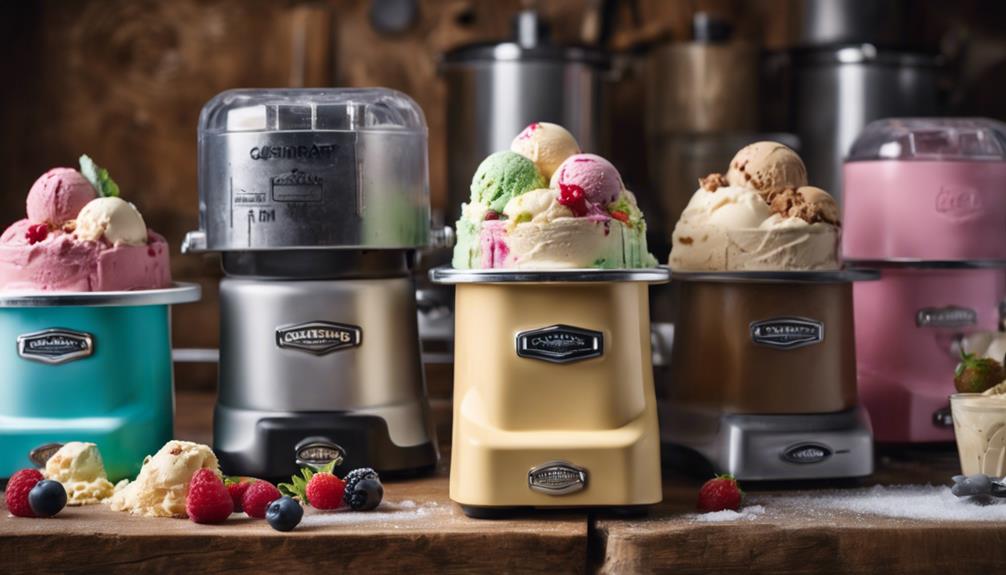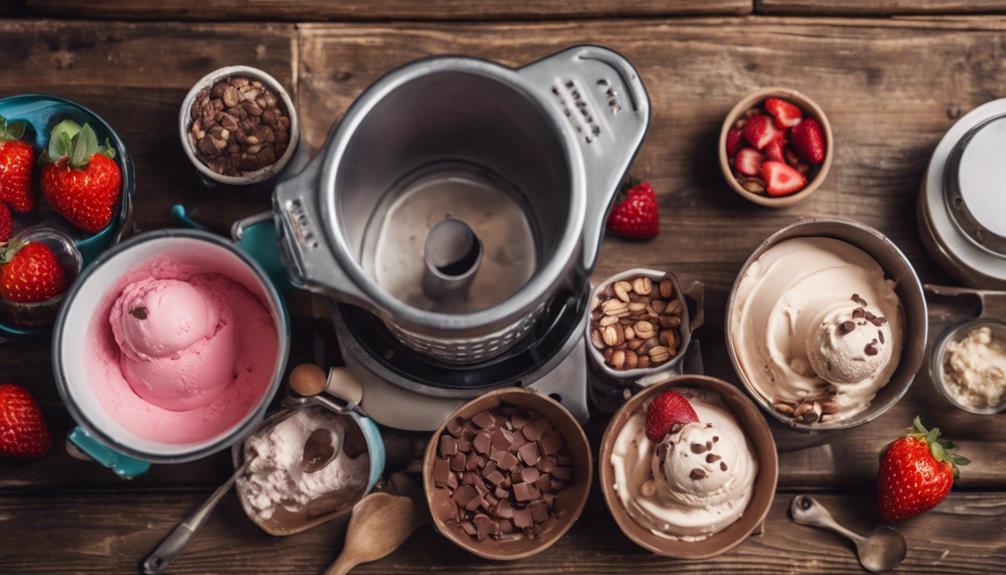You can whip up delicious gluten-free ice cream at home using just a few simple ingredients like heavy whipping cream, sweetened condensed milk, vanilla extract, and salt. Mix and whip the ingredients, then freeze them in a loaf pan for 4-6 hours for a creamy texture. Want to get creative? Try adding cocoa powder for a chocolate indulgence or smash fresh berries for a fruity twist. There are also dairy-free options using coconut cream if you prefer. Keep exploring for tips on serving and troubleshooting any texture issues you might encounter along the way!
Key Takeaways
- Use simple ingredients like heavy whipping cream, sweetened condensed milk, vanilla extract, and salt for a basic gluten-free ice cream recipe.
- Experiment with flavors by adding cocoa powder for chocolate or smashed fresh berries for fruity variations.
- For a dairy-free option, substitute full-fat coconut cream and sweetened condensed coconut milk in the recipe.
- Ensure low moisture content in ingredients to maintain a creamy texture and prevent ice crystal formation.
- Serve immediately from the freezer and consider a sundae bar for customizable options and minimal melting.
Making Gluten-Free Ice Cream
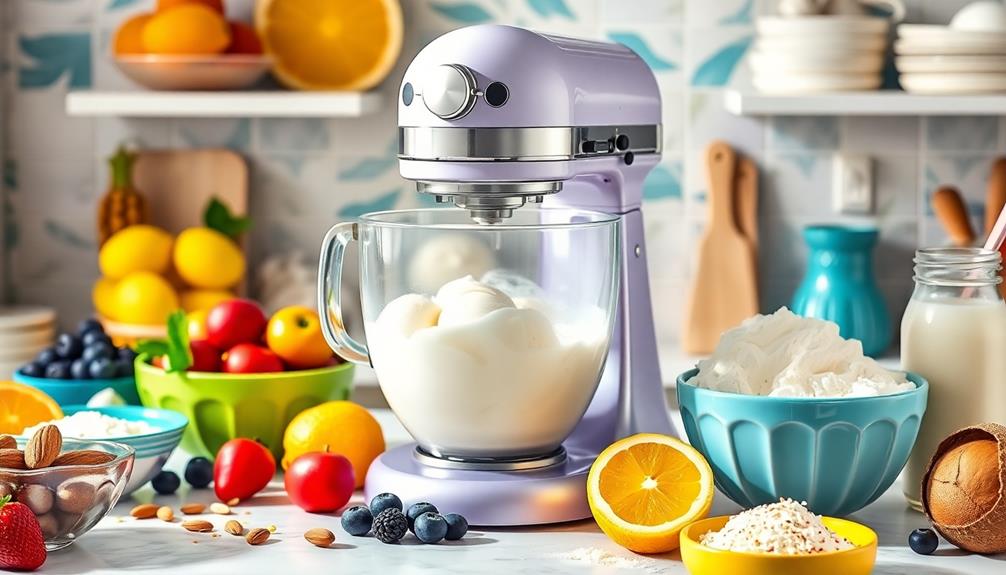
Have you ever wondered how easy it's to make gluten-free ice cream at home? With just a few simple ingredients, you can whip up a delicious no-churn ice cream that's safe for those with gluten sensitivities.
Start with heavy whipping cream, which gives your ice cream that creamy texture you crave. Combine it with sweetened condensed milk for sweetness and richness, then add a splash of vanilla extract for flavor.
The best part? You don't need an ice cream maker! Simply mix the ingredients in a bowl, ensuring you gently incorporate them to keep the airiness.
If you're a chocolate lover, feel free to stir in some cocoa powder, creating a delightful chocolate gluten-free ice cream. Just be cautious with any mix-ins you choose; many store-bought options may contain gluten. Instead, consider adding homemade gluten-free brownies or cookie dough for a tasty twist.
In just a few steps, you'll have a creamy, dreamy dessert that doesn't form ice crystals, making it the perfect treat for any occasion.
Enjoy your homemade creation, knowing it's gluten-free and absolutely delicious!
Flavor Variations

You can easily enhance your gluten-free ice cream with rich chocolate flavors by adding cocoa powder or by mixing in gluten-free cookie dough for a delicious twist.
If you prefer fruity options, consider smashing up some berries to create a revitalizing raspberry or strawberry ice cream.
With these flavor variations, you'll find endless ways to customize your frozen treat!
Chocolate Flavor Enhancements
When crafting the perfect gluten-free chocolate ice cream, enhancing the flavor can take your creation to the next level. Start by incorporating 1/4 cup of unsweetened cocoa powder into your base mixture. This will give you a rich chocolate flavor that's simply irresistible.
To elevate the texture and add delightful bursts of chocolate, toss in some mini chocolate chips or gluten-free cookie pieces.
If you're in the mood for something invigorating, consider a mint chocolate chip variation. Just mix in a splash of mint extract along with those chocolate chips for a cool twist on this classic flavor.
Another option is to sweeten with honey, which introduces a unique flavor profile that beautifully complements the chocolate.
While it's tempting to think about fruity additions, remember to focus on the chocolate.
Fruity Flavor Combinations
Fruity flavor combinations can transform your gluten-free ice cream into a revitalizing delight. To create a rejuvenating fruity twist, simply mix in 1/2 cup of smashed fresh berries like raspberries or strawberries into your ice cream base. This not only enhances the taste but also adds vibrant color.
If you want to elevate the flavor profile, consider using natural sweeteners like honey to sweeten your base, which pairs beautifully with the fruity additions.
For a fun variation, try folding in some gluten-free cookie dough for a chewy texture that complements the fruity flavors. You can also experiment by adding 1/4 cup of unsweetened cocoa powder to create a chocolate flavor that goes well with your berry mix-ins.
Want something cool and rejuvenating? Incorporate mint extract along with chocolate chips for a mint chocolate chip flavor that offers a delightful contrast to the fruity notes.
Dairy-Free Options
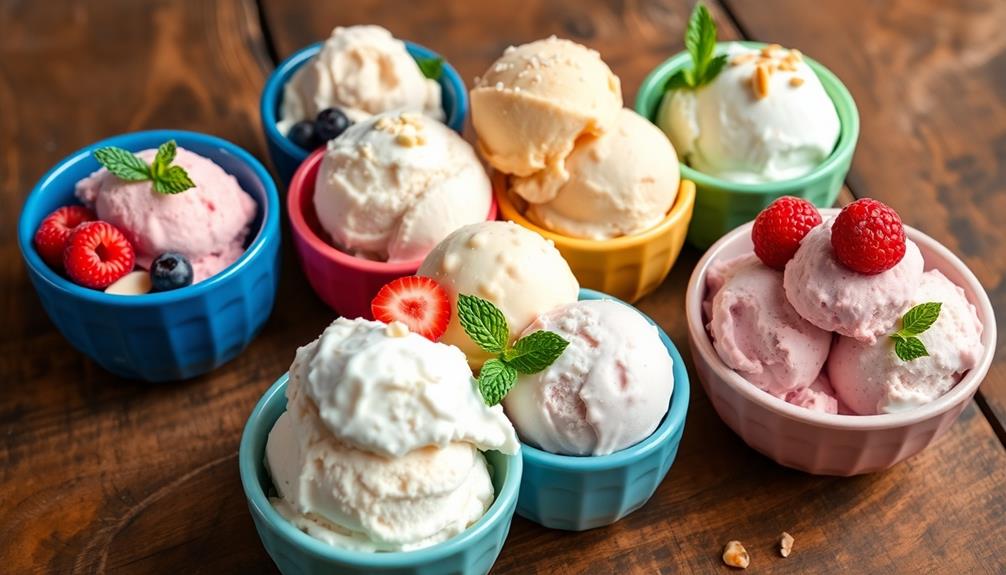
If you're looking for dairy-free options for your gluten-free ice cream, coconut cream is a fantastic substitute for heavy whipping cream, giving you that rich texture you crave.
You can also use sweetened condensed coconut milk to replace regular condensed milk, ensuring your treat stays both gluten-free and dairy-free.
While these substitutes may change the texture a bit, they enhance the flavor and provide a delicious, creamy base for your ice cream creations.
Coconut Cream Alternatives
For those looking to create delicious dairy-free ice cream, coconut cream is a fantastic alternative that adds a rich, creamy texture you won't want to miss. Using full-fat coconut cream in your homemade gluten-free recipes allows you to mimic the indulgence of traditional ice creams without any dairy.
To achieve the best results, refrigerate the coconut cream overnight to separate the cream from the liquid.
When making your dairy-free ice cream, consider enhancing the flavor with vanilla to create a delightful vanilla ice cream gluten alternative. The distinct flavor of coconut can be complemented with mix-ins like fresh fruits or gluten-free cookies, providing both texture and taste that everyone will enjoy.
You'll find that coconut cream not only keeps your ice cream rich and creamy but also allows for endless customization. Whether you're making a classic vanilla base or experimenting with other flavors, this coconut alternative guarantees your ice cream remains decadent and satisfying.
Sweetened Condensed Coconut Milk
Coconut cream isn't the only dairy-free ingredient that can elevate your homemade ice cream. Sweetened condensed coconut milk is a fantastic alternative to traditional sweetened condensed milk, making it perfect for anyone on a vegan or lactose-intolerant diet.
It's typically made from full-fat coconut milk and sugar, yielding a rich and creamy texture that mimics the classic version.
When you're crafting your ice cream recipe, you can easily substitute sweetened condensed coconut milk in a 1:1 ratio. This means you won't have to worry about adjusting your measurements, allowing for seamless integration into various desserts.
The sweetness and creaminess remain intact, ensuring your ice cream is just as delightful without the dairy.
Before you plunge into your recipe, make sure to check the labels on the canned sweetened condensed coconut milk. You'll want to confirm it's gluten-free and free from any additives that might contain gluten.
With this simple switch, you can create delicious, creamy ice cream that everyone can enjoy, regardless of dietary restrictions. Get ready to indulge in a guilt-free treat!
Texture and Flavor Differences
Dairy-free ice cream options offer a creamy texture that rivals traditional ice cream, but they come with distinct flavor profiles. When you use full-fat coconut cream, you'll achieve a rich and smooth consistency that feels indulgent. However, the coconut base can infuse a subtle tropical flavor that might differ from what you're used to with dairy ice cream.
You'll also discover flavor variations when experimenting with other bases like almond or oat milk. Each alternative brings its unique taste and texture, allowing you to customize your dairy-free ice cream to your liking.
To enhance the sweetness without gluten, consider incorporating natural sweeteners like maple syrup or agave. These options not only improve the flavor but also align with health-conscious choices.
While dairy-free ice cream may not always mimic the exact texture of conventional varieties, using the right ingredient ratios and techniques can make a significant difference. Opt for low moisture content to create a smooth and creamy final product that satisfies your cravings.
With these tips, you can enjoy delicious dairy-free ice cream without sacrificing texture or flavor.
Recipe Overview

If you're looking for a simple and delicious way to enjoy gluten-free ice cream, this recipe is perfect for you. With just four main ingredients—heavy cream, sweetened condensed milk, vanilla extract, and a pinch of salt—you'll create a creamy, homemade ice cream without any fuss. You don't even need an ice cream maker!
Here's what you can expect from this recipe:
- Quick preparation: Mix and whip ingredients in no time.
- Creamy texture: Heavy cream and sweetened condensed milk keep it rich.
- No special equipment: Freeze the mixture in a loaf pan for 4-6 hours.
- Customizable flavors: Add cocoa powder, fruit purees, or gluten-free cookie dough.
- Optional mix-ins: Stir in chocolate chips or nuts for extra crunch.
This gluten-free ice cream recipe not only satisfies your sweet tooth but also allows for flavor variations, ensuring everyone can enjoy a scoop (or two) of this delightful treat.
Key Techniques

To create the perfect gluten-free ice cream, mastering a few key techniques is essential for achieving that velvety texture and rich flavor.
Begin by ensuring the ingredients you use have low moisture content; this helps prevent ice crystal formation during freezing. In your mixing bowl, combine 14 oz of sweetened condensed milk with 2 cups of heavy whipping cream to maintain the right consistency and richness.
When you're ready to incorporate your chosen ice cream flavors, like cocoa powder or fruit purees, fold the whipped cream gently into the mixture. This step is vital; it preserves the airiness of the whipped cream, enhancing the overall mouthfeel and creaminess of your ice cream.
If you find your batch is too hard, don't hesitate to add a little more sweetened condensed milk. It'll help improve that texture.
Additionally, if the mixture seems too soft, consider whipping the cream a bit longer before you fold it in.
These techniques will keep your gluten-free recipes deliciously creamy and enjoyable every time you scoop!
Best Practices for Serving

Serving gluten-free ice cream at its best means paying attention to a few key practices that keep it creamy and delicious.
First, always serve gluten-free ice cream directly from the freezer. This helps maintain its texture and prevents thawing, which can lead to a less appealing consistency. Use 2-quart freezer-safe containers with a lid to avoid freezer burn and preserve quality.
To guarantee your ice cream stays cool and ready to serve, follow these tips:
- Avoid letting the ice cream sit out for too long before serving.
- Regularly check for signs of freezer burn or unusual odors.
- Consider setting up a sundae bar with gluten-free toppings, allowing guests to create their own ice cream sandwiches or use ice cream cones.
- Keep extra spoons handy for easy serving.
- Serve small portions to minimize melting and maintain creaminess.
Nutrition Information
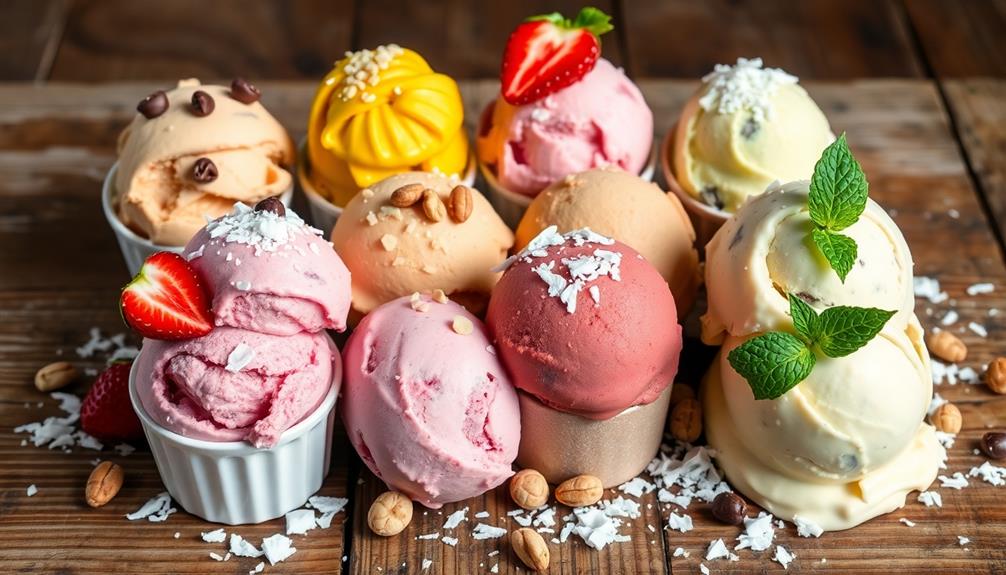
Understanding the nutrition information of gluten-free ice cream is essential for making informed dietary choices. A typical serving size of this treat, which is about two scoops, contains approximately 387 calories.
You should pay attention to the fat content, as it has around 24g of total fat, with 13g being saturated fat. If you're monitoring your sugar intake, keep in mind that each serving offers about 38g of carbohydrates, including a significant 32g of sugar.
For those with specific dietary restrictions, note that gluten-free ice cream contains approximately 60mg of cholesterol and 177mg of sodium. These figures can impact your overall health, especially if you're following a heart-healthy diet.
On the positive side, gluten-free ice cream can provide valuable nutrients, like calcium, which is around 360mg per serving, helping you meet your daily needs. Additionally, it offers about 485mg of potassium.
Community Interaction

Enjoying gluten-free ice cream doesn't just stop at savoring that delicious scoop; it's also about connecting with others who share your passion. Community interaction is essential in enhancing your gluten-free ice cream experience. By engaging with fellow enthusiasts, you can exchange recipes, discuss natural ingredients, and explore different flavors together.
Here are some ways to foster this interaction:
- Share your recipe outcomes: Let others know how your gluten-free creations turned out.
- Ask questions: If you're unsure about a certain ingredient or brand, don't hesitate to reach out.
- Provide feedback: Your insights on recipe modifications can help others in the community.
- Join social media: Tag your ice cream creations and use dedicated hashtags to connect with like-minded individuals.
- Leave a comment: Engage in discussions on platforms that encourage sharing experiences and advice.
This collaborative spirit not only enriches your ice cream-making journey but also builds a supportive network of gluten-free lovers.
Troubleshooting Tips
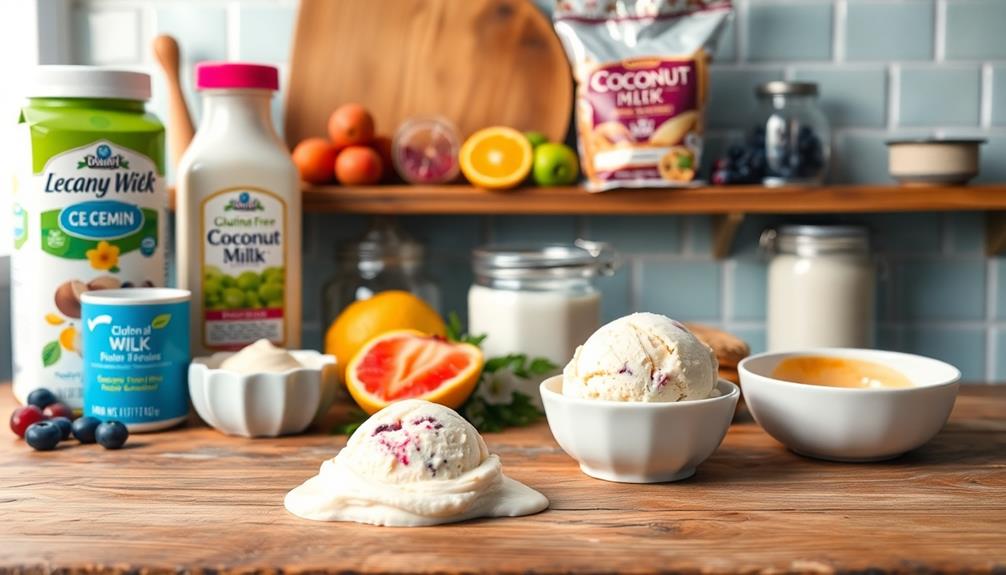
Troubleshooting common issues with gluten-free ice cream can make all the difference in achieving that perfect scoop.
If your ice cream's texture is grainy, it might be due to overcooking the custard base. Make certain you cook it just until it coats the back of a spoon and strain to remove any lumps.
If the ice cream is too hard, consider adding more sweetened condensed milk to enhance creaminess or whip the cream longer before folding it in to incorporate more air.
For ice cream that turns out too soft, check that all your ingredients were properly chilled before mixing and ascertain that the mixture was frozen for at least 4-6 hours as recommended.
To prevent ice crystal formation, keep the moisture content low in your ingredients and store the ice cream in a tight-sealing container to avoid freezer burn.
Regularly check for signs of freezer burn or odor absorption, and store your ice cream in a cool part of the freezer to maintain peak quality.
With these tips, you'll be on your way to perfecting your gluten-free ice cream creations!
Frequently Asked Questions
What Makes Ice Cream Gluten Free?
Ice cream's typically gluten-free because its main ingredients—cream, sugar, and flavorings—don't contain gluten. Just watch out for added ingredients and check labels to confirm you're enjoying a truly gluten-free treat.
Is Blizzard Ice Cream Gluten Free?
Did you know that about 1 in 100 people have celiac disease? Blizzard ice cream isn't always gluten-free. Check specific flavors and ingredients, and ask staff about cross-contamination to stay safe while enjoying.
Are Mcdonald's Ice Cream Gluten Free?
Yes, McDonald's ice cream products are generally gluten-free, but cross-contamination can happen. Always check local allergen information for specifics on flavors or toppings, as some may contain gluten-containing ingredients. Stay informed and enjoy!
Is Sherbet Gluten Free?
Imagine a vibrant scoop of sherbet, bursting with fruit flavor. Generally, it's gluten-free, but you should check labels for hidden ingredients. Always verify that what you choose is safe for your dietary needs.
Conclusion
Whether you're whipping up classic vanilla, experimenting with exotic flavors, or crafting dairy-free delights, making gluten-free ice cream is a fun and rewarding experience. Embrace the creativity, savor the taste, and enjoy the satisfaction of serving a delicious treat that everyone can enjoy. With the right techniques, the best ingredients, and a little patience, you'll be delighting friends and family with your homemade creations. So grab your ice cream maker and start your sweet adventure today!


